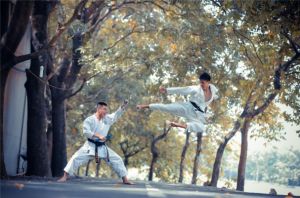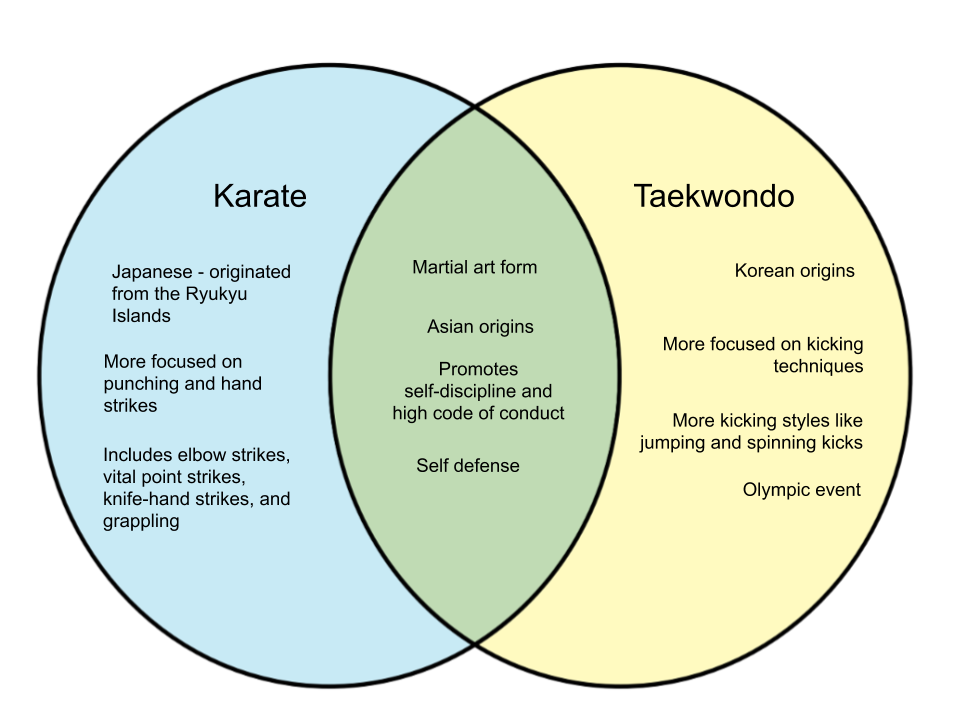Difference between revisions of "Difference Between Karate and Taekwondo"
(Created page with "thumb|Karate and Taekwondo are martial arts. There is a large selection when it comes to martial arts such as karate and taekwo...") |
|||
| Line 27: | Line 27: | ||
| Instructor || Sensei || Sa bum nim | | Instructor || Sensei || Sa bum nim | ||
|} | |} | ||
| + | === Venn Diagram === | ||
[[File:Difference-Between-Karate-and-Taekwondo.png|center]] | [[File:Difference-Between-Karate-and-Taekwondo.png|center]] | ||
Latest revision as of 22:35, 3 September 2020
There is a large selection when it comes to martial arts such as karate and taekwondo. These two martial art forms are often confused since they both incorporate kicking and hand techniques. Here are some qualities that differentiate karate and taekwondo.
Karate[edit]
Karate is a Japanese martial art form that places more focus on striking arts, particularly hand strikes. It originated from the Ryukyu Islands (now Okinawa) but was mainly influenced by Chinese kung fu. Karate is composed of punching, palm and hand strikes, knee and elbow strikes, as well as kicking. It also incorporates other methods like grappling, restraint, throwing, knife-hands, and vital-point strikes. A practitioner of karate is called a karateka.
Taekwondo[edit]
Taekwondo is a Korean martial art form that places emphasis on kicking. It is one of the faster martial art forms. Taekwondo is composed of head-height kicks, spinning kicks, jumping kicks, and fast kicking techniques, but is not limited to such. It also teaches techniques like blocking, parries, punches, takedowns and throws. Taekwondo practitioners are generally referred to as taekwondo-in.
| Karate | Taekwondo | |
|---|---|---|
| Definition | A Japanese martial art focused on powerful, unarmed strikes | A Korean martial art centered on kicks; one of the faster martial arts |
| Origin | Ryukyu Islands, now Okinawa, Japan | Korea |
| History | Karate started in Japan when trade relationships were made with the Ming Dynasty and brought Chinese populations into Japan. Kung Fu, particularly the Fujian White Crane style, eventually influenced the Japanese and evolved into karate | Taekwondo began as separate styles, when those versed in Chinese, Korean and Japanese martial arts began opening schools called Kwan in Korea. The teachings were eventually merged into taekwondo after the urging of South Korean President Syngman Rhee |
| Techniques | Punching, hand strikes, palm strikes, knee strikes, elbow strikes, grappling, kicking, vital-point strikes, knife-hand strikes, throwing, restraint, and many others | Head-height kicks, spinning kicks, jumping kicks, fast kicking techniques, punching, parrying, throwing, takedowns |
| Major Organizations | World Karate Federation, Japan Karate Federation, USA National Karate-Do Organization, International Karate Association, Kenkojuku Karate Association | World Taekwondo Federation, International Taekwondo Federation |
| Olympics | No | Yes |
| Instructor | Sensei | Sa bum nim |

